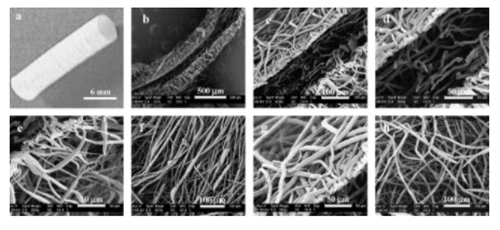Copyright © 2022 Foshan MBRT Nanofiberlabs Technology Co., Ltd All rights reserved.Site Map
Aiming to develop a scaffold architecture mimicking morphological and mechanically that of a blood vessel, a sequential multi-layering electrospinning (ME) was performed on a rotating mandrel-type collector. A bi-layered tubular scaffold composed of a stiff and oriented PLA outside fibrous layer and a pliable and randomly oriented PCL fibrous inner layer (PLA/PCL) was fabricated. Control over the level of fibre orientation of the different layers was achieved through the rotation speed of the collector. The structural and mechanical properties of the scaffolds were examined using scanning electron microscopy (SEM) and tensile testing. To assess their capability to support cell attachment, proliferation and migration, 3T3 mouse fibroblasts and later human venous myofibroblasts (HVS) were cultured, expanded and seeded on the scaffolds. In both cases, the cell-polymer constructs were cultured under static conditions for up to 4 weeks. Environmental-scanning electron microscopy (SEM), confocal laser scanning microscopy (CLSM), histological examination and biochemical assays for cell proliferation (DNA) and extracellular matrix production (collagen and glycosaminoglycans) were performed. The findings suggest the feasibility of ME to design scaffolds with a hierarchical organization through a layer-by-layer process and control over fibre orientation. The resulting scaffolds achieved the desirable levels of pliability (elastic up to 10% strain) and proved to be capable to promote cell growth and proliferation. The electrospun PLA/PCL bi-layered tube presents appropriate characteristics to be considered a candidate scaffold for blood vessel tissue engineering.

Published: 2005
Journal :ACTA BIOMATER
Impact Factor:7.764
Paper link:https://www.sciencedirect.com/science/article/pii/S1742706105000954